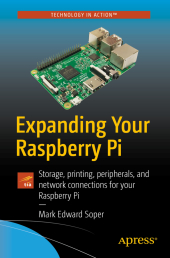 Neuerscheinungen 2017Stand: 2020-02-01 |
Schnellsuche
ISBN/Stichwort/Autor
|
Herderstra▀e 10
10625 Berlin
Tel.: 030 315 714 16
Fax 030 315 714 14
info@buchspektrum.de |

Mark Soper
Expanding Your Raspberry Pi
Storage, printing, peripherals, and network connections for your Raspberry Pi
1st ed. 2017. xv, 204 S. 1 SW-Abb., 163 Farbabb. 235 mm
Verlag/Jahr: SPRINGER, BERLIN; APRESS 2017
ISBN: 1-484-22921-5 (1484229215)
Neue ISBN: 978-1-484-22921-7 (9781484229217)
Preis und Lieferzeit: Bitte klicken
Gain a deeper understanding of how Raspberry Pi works to get the results you want right in the palm of your hand. This book helps you understand the right connections and software to drive your Raspberry Pi into opening the worlds of programming, electronic experiments, system control, digital imaging, and the Internet of Things to you.
You┤ll discover how to expand your Pi┤s storage for bigger programs, use its onboard connections to interface with cameras and control devices, printers and scanners. You┤ll also see how to share information with Windows and Apple computers and mobile devices, and use it away from AC power. You┤ll be able to turn any HDTV into a media player; stream and share files from desktop and mobile devices; use your Pi for image capture via camera or scanner; and more!
Expanding Your Raspberry Pi is your guide to doing almost anything a bigger computer can do - if you┤re ready for the challenge.
What You┤ll Learn
Connect, use, and manage mass storage devices for greater versatility
Link with desktop, laptop, and mobile devices using the Pi┤s built-in Wi-Fi and Bluetooth features
Share resources from your Pi with desktop and mobile devices
Capture video and still photos with your Pi
Who This Book Is For
Network administrators: Connect Raspberry Pi devices to other devices on a wired or wireless network for media streaming, file serving, or print serving
Teachers: Use Raspberry Pi to teach students how to connect different types of computers and operating systems with each other.
IT workers: Use Raspberry Pi with your existing printers, scanners, webcams, and home network
Chapter 1 title: Raspberry Pi System Anatomy
˙ Chapter Goal: Choosing the best Pi for your appetite
˙ Model overview
˙ CPU and RAM
˙ Ports
˙ Board-level connectors
˙ Integrated network features
Chapter 2 title: The Distro Bunch
Chapter Goal: Choosing the right OS for your expansion purpose
˙ Raspbian
˙ Other Linux distros
˙ Windows 10 IoT Core
˙ Choosing the best distro for the task
˙ Creating your media
Chapter 3 title: Adding Mass Storage
Chapter Goal: Connect, use, and manage flash memory cards, USB flash drives, and hard drives
˙ Hardware used in this chapter
˙ Adding and using an external hard drive
˙ Partitioning a flash memory card
˙ USB flash drive issues and solutions
˙ Installing apps to external storage
˙ Troubleshooting
Chapter 4 title: Connecting to a Workgroup Network
Chapter Goal: How to connect to a SOHO network so that information can be shared between other network clients and the Raspberry Pi
˙ Hardware used in this chapter
˙ Distro and Raspberry Pi configuration
˙ Windows configuration
˙ OS X configuration
˙ Android
˙ iOS
˙ File transfers
˙ Printing to a network printer
˙ Scanning with a network scanner
˙ Troubleshooting
Chapter 5 title: Sharing an Internet connection
Chapter Goal: Sharing the Raspberry Pi┤s Internet connection with mobile devices
˙ Hardware used in this chapter
˙ Configuring the Pi for sharing
˙ Connecting to the Pi with Android
˙ Connecting to the Pi with iOS
˙ Troubleshooting
Chapter 6 title: Setting up a print and scan server
Chapter Goal: How to use a Raspberry Pi as a print server
˙ Hardware used in this chapter
˙ Connecting via USB
˙ Configuring CUPS
˙ Configuring SANE (scanner) and SNAC (scanner for OS X)
˙ Setting up users
˙ Troubleshooting
Chapter 7 title: Imaging and Video
Chapter Goal: How to capture still images and video that can be used with other devices
˙ Hardware used in this chapter
˙ Raspberry Pi camera
˙ Webcam
˙ Time lapse and motion triggers
˙ Image scanners
˙ Troubleshooting
Chapter 8 title: Media Serving
Chapter Goal: Using your Raspberry Pi for media serving across a network
˙ Hardware used in this chapter
˙ Selecting a distro
˙ Storage requirements
˙ Configuration
˙ Troubleshooting
Chapter 9 title: GPIO Anatomy and Applications
Chapter Goal: Understanding the Raspberry PI┤s GPIO Interface and its uses
˙ Hardware used in this chapter
˙ Pinouts
˙ Typical applications
˙ Using a Gertboard
˙ Troubleshooting
Chapter 10 title: Taking Your Raspberry Pi on the Road
Chapter Goal: Running Your Raspberry Pi on Battery Power
˙ Choosing a power source
˙ Configuring the Raspberry Pi for minimal power consumption
˙ Choosing low-power peripherals
˙ Low-power warnings
˙ Troubleshooting


